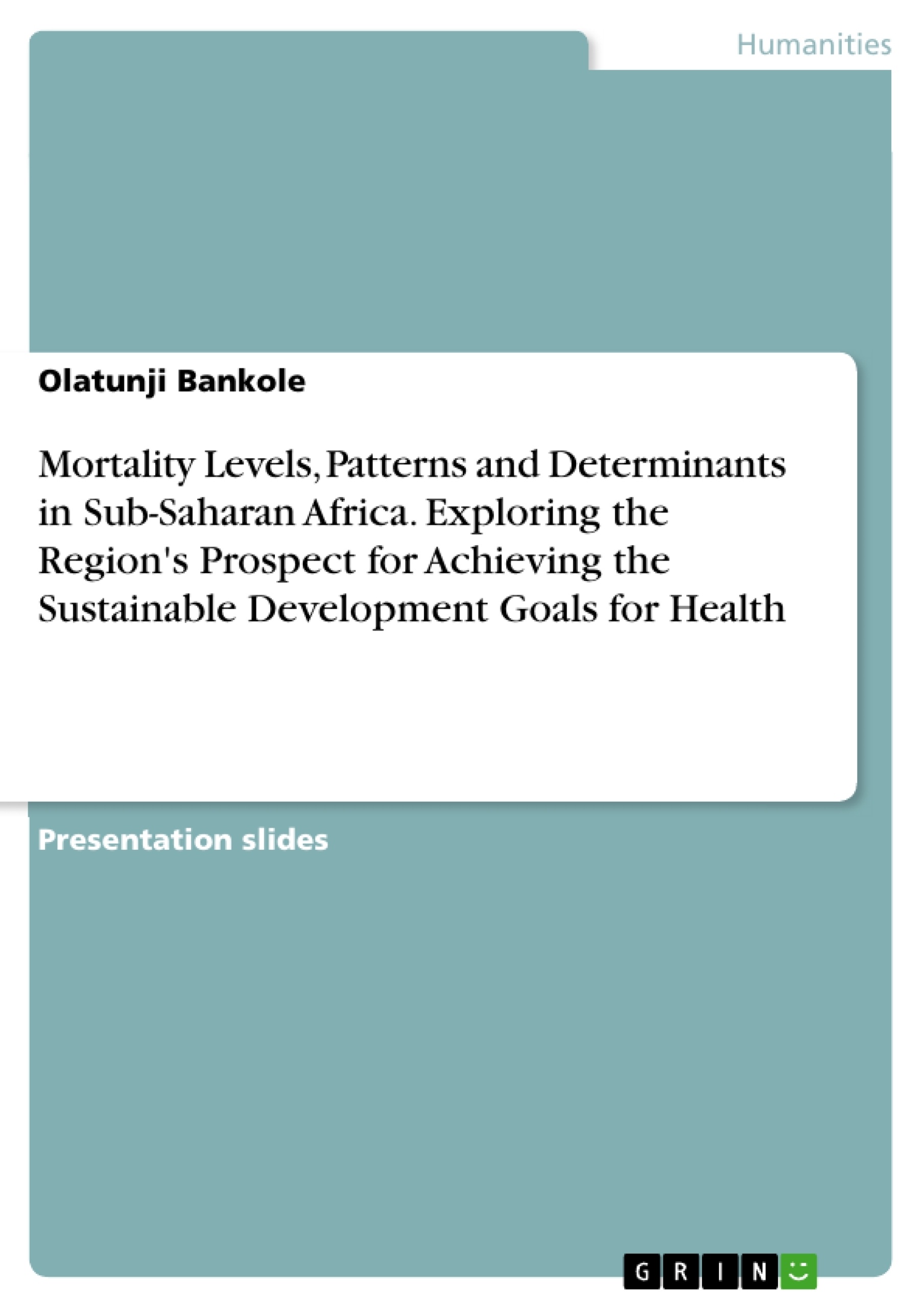The life expectancy rates are lower in the sub-Saharan African region than in any other region of the world. Therefore, this presentation strives to draw attention to the determinants of mortality there. The goal is to extensively review the level and patterns of mortality in the area, to further explore the determining factors responsible for prevalence levels of mortality in the sub-Sharan African regions, and to explore the sub-Sahara region's prospect for achieving the Sustainable Development Goals for Health.
Evidently, there are needs to be met and actions to be taken. While being exposed to the dangers of malaria, mental health and high infant mortality, striving for the attainment of the Sustainable Development Goals for Health in the region is non-negotiable.
Inhaltsverzeichnis (Table of Contents)
- Scope of the Study
- Introduction
- Mortality Theories
- Level and Patterns of Global Mortality
- Level and Patterns of Mortality in sub-Saharan Africa
- Determinants of Mortality in sub-Saharan Africa
- Prospect for Achieving the Sustainable Development Goals for Health in sub-Saharan Africa
- Conclusion
- Areas of Further Research
Zielsetzung und Themenschwerpunkte (Objectives and Key Themes)
This paper aims to examine mortality levels, patterns, and determinants in sub-Saharan Africa, exploring the region's prospects for achieving the Sustainable Development Goals for Health. The study also intends to review existing mortality theories and their applicability to the context of sub-Saharan Africa.
- Mortality Trends and Patterns in Sub-Saharan Africa
- Factors Influencing Mortality Levels in the Region
- The Role of Socioeconomic and Cultural Factors in Mortality
- The Impact of Global Health Initiatives on Mortality Rates
- The Prospects for Achieving the Sustainable Development Goals for Health in Sub-Saharan Africa
Zusammenfassung der Kapitel (Chapter Summaries)
The introduction defines mortality and discusses its significance as a component of population change. It highlights the global differentials in mortality trends and patterns, attributing them to variations in socioeconomic and cultural factors. The paper then outlines its objectives, focusing on exploring the level and patterns of mortality in sub-Saharan Africa, examining the factors influencing mortality levels, and assessing the region's prospects for achieving the Sustainable Development Goals for Health.
The chapter on mortality theories examines two prominent frameworks: the Epidemiological Transition Theory and the Demographic Transition Theory. The Epidemiological Transition Theory describes the shift in mortality patterns from infectious diseases to chronic diseases, while the Demographic Transition Theory focuses on the changing patterns of births and deaths in relation to population growth. The paper discusses the implications of these theories for understanding mortality in sub-Saharan Africa.
The chapter on the level and patterns of global mortality reviews the significant decline in early childhood and maternal mortality observed globally over the past 25 years. It highlights the slower decline in mortality rates in less developed countries, particularly in sub-Saharan Africa and Southeast Asia. This section analyzes the reasons for these variations, including differences in socioeconomic status, access to healthcare, and cultural practices.
The chapter on the level and patterns of mortality in sub-Saharan Africa explores the region's challenges in reducing mortality rates. It examines the life expectancy rates, which are lower in sub-Saharan Africa than in any other region of the world, and discusses the factors contributing to this disparity. The chapter also analyzes the regional variations in mortality rates, with the Central African region experiencing the highest mortality levels and Eastern Africa the lowest.
The chapter on determinants of mortality in sub-Saharan Africa examines the underlying factors contributing to the high mortality rates in the region. It explores the role of poverty, limited access to healthcare, inadequate sanitation, and the prevalence of infectious diseases. This chapter provides a comprehensive analysis of the multifaceted nature of mortality determinants in sub-Saharan Africa.
The chapter on the prospect for achieving the Sustainable Development Goals for Health in sub-Saharan Africa assesses the region's potential to meet the ambitious goals set by the United Nations. It examines the challenges and opportunities associated with improving health outcomes in the region, focusing on the need for targeted interventions and sustainable development initiatives.
Schlüsselwörter (Keywords)
This paper focuses on the major keywords including mortality, sub-Saharan Africa, Sustainable Development Goals, health, epidemiology, demographic transition, socioeconomic factors, healthcare access, maternal mortality, childhood mortality, and infectious diseases. These keywords represent the core themes and concepts explored in the paper, providing a framework for understanding mortality trends, patterns, and determinants in the region.
- Quote paper
- Olatunji Bankole (Author), 2017, Mortality Levels, Patterns and Determinants in Sub-Saharan Africa. Exploring the Region's Prospect for Achieving the Sustainable Development Goals for Health, Munich, GRIN Verlag, https://www.grin.com/document/370336



